Prince Edward Island (PEI) is a province of Canada consisting of the island of the same name, and several much smaller islands.
Prince Edward Island is one of the three Maritime Provinces and is the smallest province in both land area and population. It is part of the traditional lands of the Mi'kmaq, and became a British colony in the 1700s and was federated into Canada as a province in 1873. Its capital is Charlottetown. According to the 2016 census, the province of Prince Edward Island has 142,907 residents.
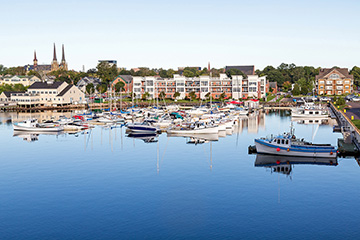
The backbone of the economy is farming; it produces 25% of Canada's potatoes. The island has several informal names: "Garden of the Gulf," referring to the pastoral scenery and lush agricultural lands throughout the province; and "Birthplace of Confederation" or "Cradle of Confederation", referring to the Charlottetown Conference in 1864, although PEI did not join Confederation until 1873, when it became the seventh Canadian province. Historically, PEI is one of Canada's older settlements and demographically still reflects older immigration to the country, with Celtic, Anglo-Saxon and French surnames being dominant to this day.
PEI is located about 200 kilometres (120 miles) north of Halifax, Nova Scotia and 600 kilometres (370 miles) east of Quebec City. It consists of the main island and 231 minor islands. Altogether, the entire province has a land area of 5,686.03 km2 (2,195.39 sq mi). The main island is 5,620 km2 (2,170 sq mi) in size, slightly larger than the U.S. state of Delaware. It is the 104th largest island in the world and Canada's 23rd largest island. PEI is the only subnational jurisdiction of North America outside the Caribbean to have no mainland territory, and the only such jurisdiction to have no land boundary.
Geography
Prince Edward Island is located in the Gulf of St. Lawrence, west of Cape Breton Island, north of the Nova Scotia peninsula, and east of New Brunswick. Its southern shore bounds the Northumberland Strait. The island has two urban areas. The largest surrounds Charlottetown Harbour, situated centrally on the island's southern shore, and consists of the capital city Charlottetown, and suburban towns Cornwall and Stratford and a developing urban fringe. A much smaller urban area surrounds Summerside Harbour, situated on the southern shore 40 km (25 mi) west of Charlottetown Harbour, and consists primarily of the city of Summerside. As with all natural harbours on the island, Charlottetown and Summerside harbours are created by rias.
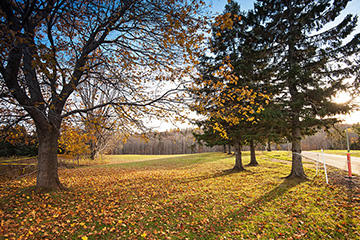
The island's landscape is pastoral. Rolling hills, woods, reddish white sand beaches, ocean coves and the famous red soil have given Prince Edward Island a reputation as a province of outstanding natural beauty. The provincial government has enacted laws to preserve the landscape through regulation, although there is a lack of consistent enforcement, and an absence of province-wide zoning and land-use planning. Under the Planning Act of the province, municipalities have the option to assume responsibility for land-use planning through the development and adoption of official plans and land use bylaws. Thirty-one municipalities have taken responsibility for planning. In areas where municipalities have not assumed responsibility for planning, the Province remains responsible for development control.
The island's lush landscape has a strong bearing on its economy and culture. The author Lucy Maud Montgomery drew inspiration from the land during the late Victorian Era for the setting of her classic novel Anne of Green Gables (1908). Today, many of the same qualities that Montgomery and others found in the island are enjoyed by tourists who visit year-round. They enjoy a variety of leisure activities, including beaches, various golf courses, eco-tourism adventures, touring the countryside, and enjoying cultural events in local communities around the island.
The smaller, rural communities as well as the towns and villages throughout the province, retain a slower-paced, old-world flavour. Prince Edward Island has become popular as a tourist destination for relaxation. The economy of most rural communities on the island is based on small-scale agriculture. Industrial farming has increased as businesses buy and consolidate older farm properties.
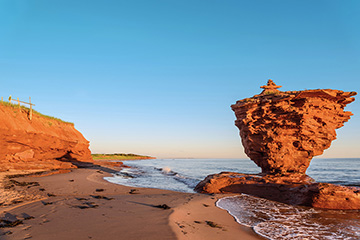
The coastline has a combination of long beaches, dunes, red sandstone cliffs, salt water marshes, and numerous bays and harbours. The beaches, dunes and sandstone cliffs consist of sedimentary rock and other material with a high iron concentration, which oxidises upon exposure to the air. The geological properties of a white silica sand found at Basin Head are unique in the province; the sand grains cause a scrubbing noise as they rub against each other when walked on, and have been called the "singing sands".
Large dune fields on the north shore can be found on barrier islands at the entrances to various bays and harbours. The magnificent sand dunes at Greenwich are of particular significance. The shifting, parabolic dune system is home to a variety of birds and rare plants; it is also a site of significant archeological interest.
Despite Prince Edward Island's small size and reputation as a largely rural province, it is the most densely populated province in Canada.
Climate
The climate of the island is considered to be moderate and strongly influenced by the surrounding seas. As such, it is milder than inland locations owing to the warm waters from the Gulf of St. Lawrence. The climate is characterized by changeable weather throughout the year; it has some of the most variable day-to-day weather in Canada, in which specific weather conditions seldom last for long.
During July and August, the average daytime high in PEI is 23°C (73°F); however, the temperature can sometimes exceed 30°C (86°F) during these months. In the winter months of January and February, the average daytime high is −3.3°C (26°F). The Island receives an average yearly rainfall of 855 millimetres (33.7 in) and an average yearly snowfall of 285 centimetres (112 in).

Winters are moderately cold and long but are milder than inland locations, with clashes of cold Arctic air and milder Atlantic air causing frequent temperature swings. The climate is considered to be more continental than oceanic since the Gulf of St. Lawrence freezes over, thus eliminating any moderation. The mean temperature is −7°C (19°F) in January. During the winter months, the island usually has many storms (which may produce rain as well as snow) and blizzards since during this time, storms originating from the North Atlantic or the Gulf of Mexico frequently pass through. Springtime temperatures typically remain cool until the sea ice has melted, usually in late April or early May. Summers are moderately warm, but rarely uncomfortable, with the daily maximum temperature only occasionally reaching as high as 30°C (86°F). Autumn is a pleasant season, as the moderating Gulf waters delay the onset of frost, although storm activity increases compared to the summer. There is ample precipitation throughout the year, although it is heaviest in the late autumn, early winter and mid spring.
Transportation
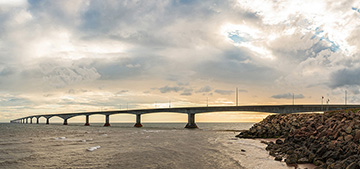
Prince Edward Island's transportation network has traditionally revolved around its seaports of Charlottetown, Summerside, Borden, Georgetown, and Souris —linked to its railway system, and the two main airports in Charlottetown and Summerside, for communication with mainland North America. The railway system was abandoned by CN in 1989 in favour of an agreement with the federal government to improve major highways.
Until 1997, the province was linked by two passenger-vehicle ferry services to the mainland: one, provided by Marine Atlantic, operated year-round between Borden and Cape Tormentine, New Brunswick; the other, provided by Northumberland Ferries Limited, operates seasonally between Wood Islands and Caribou, Nova Scotia. A third ferry service provided by CTMA operates all year round with seasonal times between Souris and Cap-aux-Meules, Quebec, in the Magdalen Islands.
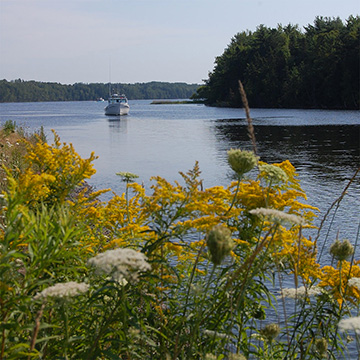
On June 1, 1997, the Confederation Bridge opened, connecting Borden-Carleton to Cape Jourimain, New Brunswick. The world's longest bridge over ice-covered waters, it replaced the Marine Atlantic ferry service. Since then, the Confederation Bridge's assured transportation link to the mainland has altered the province's tourism and agricultural and fisheries export economies.
Several airlines service the Charlottetown Airport (CYYG); the Summerside Airport (CYSU) is an additional option for general aviation.
The Island has the highest concentration of roadways in Canada. The provincially managed portion of the network consists of 3,824 kilometres (2,376 mi) of paved roadways and 1,558 kilometres (968 mi) of non-paved or clay roads.
The province has very strict laws regarding use of road-side signs. Billboards and the use of portable signs are banned. There are standard direction information signs on roads in the province for various businesses and attractions in the immediate area. Some municipalities' by-laws also restrict the types of permanent signs that may be installed on private property.
There is an extensive bicycling / hiking trail that spans the island. The Confederation Trail is a 470 kilometres (290 mi) recreational trail system. The land was once owned and used by Canadian National Railway (CN) as a rail line on the island.
Culture
The island's cultural traditions of art, music and creative writing are supported through the public education system. There is an annual arts festival, the Charlottetown Festival, hosted at the Confederation Centre of the Arts.
Lucy Maud Montgomery, who was born in Clifton (now New London) in 1874, wrote some 20 novels and numerous short stories that have been collected into anthologies. Her first Anne book Anne of Green Gables was published in 1908. The musical play Anne of Green Gables has run every year at the Charlottetown festival for more than four decades. The sequel, Anne & Gilbert, premiered in the Playhouse in Victoria in 2005. The actual location of Green Gables, the house featured in Montgomery's Anne books, is in Cavendish, on the north shore of PEI.
Elmer Blaney Harris founded an artists colony at Fortune Bridge and set his famous play Johnny Belinda on the island. Robert Harris was a well-known artist.
Prince Edward Island's documented music history begins in the 19th century with religious music, some written by the local pump and block maker and organ-importer, Watson Duchemin. Several big bands including the Sons of Temperance Band and the Charlottetown Brass Band were active. Today, Acadian, Celtic, folk, and rock music prevail, with exponents including Gene MacLellan, his daughter Catherine MacLellan, Al Tuck, Lennie Gallant, Two Hours Traffic and Paper Lions. The celebrated singer-songwriter Stompin' Tom Connors spent his formative years in Skinners Pond. Celtic music is certainly the most common traditional music on the island, with fiddling and step dancing being very common. This tradition, largely Scottish, Irish and Acadian in origin is very similar to the music of Cape Breton and to a lesser extent, Newfoundland and is unique to the region. Due to the Islands influence as a former Highlander Clans Scottish colony, a March 4/4 for bagpipes was composed in honour of Prince Edward Island. There is also an annual jazz festival, the P.E.I. Jazz and Blues Festival.
Festivals
There is an annual arts festival, the Charlottetown Festival, hosted at the Confederation Centre of the Arts as well as the Island Fringe Festival that takes place around Charlottetown. An annual jazz festival, the P.E.I. Jazz and Blues Festival is a one-week-long series of concerts taking place at several venues including Murphy's Community Center, outdoor stages, and churches in Charlottetown. The moving of its date to mid August caused in 2011 a serious loss in funding from Ottawa's regional development agency ACOA. The musician's line up in 2011 included Oliver Jones, Sophie Milman, Matt Dusk, Jack de Keyzer, Jack Semple, Meaghan Smith, Meaghan Blanchard, Hupman Brothers, Alex Dean, Charlie A'Court, Sean Ferris, Jimmy Bowskill, West End Blues Band, Bad Habits, Brian McConnell and Mellotones. There is also Canada Rocks, and the Cavendish Beach Music Festival. With agriculture and fishery playing a large role in the economy, P.E.I. has been marketed as a food tourism destination. Several food festivals have become popular such as the Fall Flavours festival and the Shellfish Festival.
History
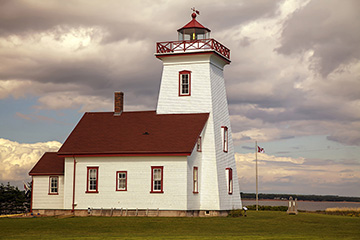
Since before the influx of Europeans, the Mi'kmaq First Nations have inhabited Prince Edward Island as part of the region of Mi'kma'ki. They named the Island Epekwitk, meaning "cradled on the waves"; Europeans represented the pronunciation as Abegweit. Another name is Minegoo. The Mi'kmaq's legend is that the island was formed by the Great Spirit placing on the Blue Waters some dark red crescent-shaped clay. There are two Mi'kmaq First Nation communities on Epekwitk today.
French colonyIn 1534, Jacques Cartier was the first European to see the island. In 1604, France claimed the lands of the Maritimes, including Prince Edward Island, establishing the French colony of Acadia. The island was named Île Saint-Jean by the French. The Mi'kmaq never recognized the claim but welcomed the French as trading partners and allies.
Battle at Port-la-Joye (1745)After the Siege of Louisbourg (1745) during the War of the Austrian Succession, the New Englanders also captured Île Saint-Jean (Prince Edward Island). An English detachment landed at Port-la-Joye. Under the command of Joseph de Pont Duvivier, the French had a garrison of 20 French troops at Port-la-Joye. The troops fled and New Englanders burned the capital to the ground. Duvivier and the twenty men retreated up the Northeast River (Hillsborough River), pursued by the New Englanders until the French troops received reinforcements from the Acadian militia and the Mi'kmaq. The French troops and their allies were able to drive the New Englanders to their boats, nine New Englanders killed, wounded or made prisoner. The New Englanders took six Acadian hostages, who would be executed if the Acadians or Mi'kmaq rebelled against New England control. The New England troops left for Louisbourg. Duvivier and his 20 troops left for Quebec. After the fall of Louisbourg, the resident French population of Île Royal were deported to France. The Acadians of Île Saint-Jean lived under the threat of deportation for the remainder of the war.
Battle at Port-la-Joye (1746)The New Englanders had a force of two war ships and 200 soldiers stationed at Port-La-Joye. To regain Acadia, Ramezay was sent from Quebec to the region to join forces with the Duc d'Anville Expedition. Upon arriving at Chignecto, he sent Boishebert to Île Saint-Jean on a reconnaissance to assess the size of the New England force. After Boishebert returned, Ramezay sent Joseph-Michel Legardeur de Croisille et de Montesson along with over 500 men, 200 of whom were Mi'kmaq, to Port-La-Joye. In July 1746, the battle happened near York River. Montesson and his troops killed forty New Englanders and captured the rest. Montesson was commended for having distinguished himself in his first independent command.
Expulsion of the AcadiansRoughly one thousand Acadians lived on the island, many of whom had fled to the island from mainland Nova Scotia during the first wave of the British-ordered expulsion in 1755, reaching a population of 5,000. However, many more were forcibly deported during the second wave of the expulsion after the Siege of Louisbourg (1758). In the Île Saint-Jean Campaign (1758) General Jeffery Amherst ordered Colonel Andrew Rollo to capture the island. Many Acadians died in the expulsion en route to France; on December 13, 1758, the transport ship Duke William sank and 364 died. A day earlier the Violet sank and 280 died; several days later Ruby sank with 213 on board.
British colonyGreat Britain claimed the island as part of Nova Scotia in 1763, when France gave up its claim to the island. This was under the terms of the Treaty of Paris which settled the Seven Years' War. The island was split into a separate colony in 1769, which the British called St. John's Island (also the Island of St. John's). The high influx of Scottish Highlanders in the late 1700s resulted in P.E.I. having the highest provincial percentage of Scottish immigrants in Canada. (Not to underestimate the highest percentage of Scottish on nearby Cape Breton Island, however only being a part thereof the province of Nova Scotia.) This, in turn, led to a higher proportion of Scottish Gaelic speakers and thriving culture surviving on P.E.I. than Scotland itself, as the settlers avoided English influence overseas. Hence the formally existing Prince Edward Island Highland Regiment founded in 1875.
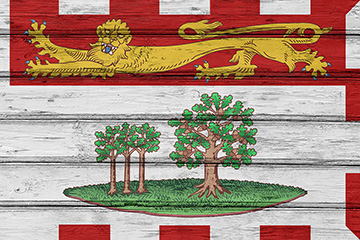
The first British governor of St. John's Island, Walter Patterson, was appointed in 1769. Assuming office in 1770, he had a controversial career during which land title disputes and factional conflict slowed the initial attempts to populate and develop the island under a feudal system. In an attempt to attract settlers from Ireland, in one of his first acts (1770) Patterson led the island's colonial assembly to rename the island "New Ireland", but the British Government promptly vetoed this as exceeding the authority vested in the colonial government; only the Privy Council in London could change the name of a colony.
Land distributionIn the mid-1760s, a survey team divided the Island into 67 lots. On July 1, 1767, these properties were allocated to supporters of King George III by means of a lottery. Ownership of the land remained in the hands of landlords in England, angering Island settlers who were unable to gain title to land on which they worked and lived. Significant rent charges (to absentee landlords) created further anger. The land had been given to the absentee landlords with a number of conditions attached regarding upkeep and settlement terms; many of these conditions were not satisfied. Islanders spent decades trying to convince the Crown to confiscate the lots, however the descendants of the original owners were generally well connected to the British government and refused to give up the land.
In 1853, the Island government passed the Land Purchase Act which empowered them to purchase lands from those owners who were willing to sell, and then resell the land to settlers for low prices. This scheme collapsed when the Island ran short of money to continue with the purchases. Many of these lands also were fertile, and were some of the key factors to sustaining Prince Edward Island's economy.
Raid on Charlottetown (1775)During the American Revolutionary War Charlottetown was raided in 1775 by a pair of American-employed privateers. Two armed schooners, Franklin and Hancock, from Beverly, Massachusetts, made prisoner of the attorney-general at Charlottetown, on advice given them by some Pictou residents after they had taken eight fishing vessels in the Gut of Canso.
During and after the American Revolutionary War, from 1776 to 1783, the colony's efforts to attract exiled Loyalist refugees from the rebellious American colonies met with some success. Walter Patterson's brother, John Patterson, one of the original grantees of land on the island, was a temporarily exiled Loyalist and led efforts to persuade others to come.
The 1787 dismissal of Governor Patterson and his recall to London in 1789 dampened his brother's efforts, leading John to focus on his interests in the United States (one of John's sons, Commodore Daniel Patterson, became a noted United States Navy hero, and John's grandsons, Rear Admiral Thomas H. Patterson and Lt. Carlile Pioou). Edmund Fanning, also a Loyalist exiled by the Revolution, took over as the second governor, serving until 1804. His tenure was more successful than Patterson's.
On November 29, 1798, during Fanning's administration, Great Britain granted approval to change the colony's name from St. John's Island to Prince Edward Island to distinguish it from similar names in the Atlantic, such as the cities of Saint John, New Brunswick and St. John's in Newfoundland. The colony's new name honoured the fourth son of King George III, Prince Edward Augustus, the Duke of Kent (1767–1820), who subsequently led the British military forces on the continent as Commander-in-Chief, North America (1799–1800), with his headquarters in Halifax. (Prince Edward later became the father of the future Queen Victoria.)
During the 19th century the colony of Prince Edward Island began to attract "adventurous Victorian families looking for elegance on the sea. Prince Edward Island became a fashionable retreat in the nineteenth century for British nobility."
Confederation
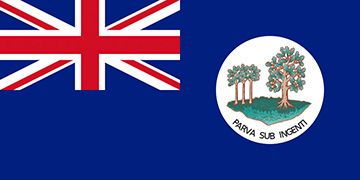
In September 1864, Prince Edward Island hosted the Charlottetown Conference, which was the first meeting in the process leading to the Quebec Resolutions and the creation of Canada in 1867. Prince Edward Island did not find the terms of union favourable and balked at joining in 1867, choosing to remain a colony of the United Kingdom. In the late 1860s, the colony examined various options, including the possibility of becoming a discrete dominion unto itself, as well as entertaining delegations from the United States, who were interested in Prince Edward Island joining the United States.
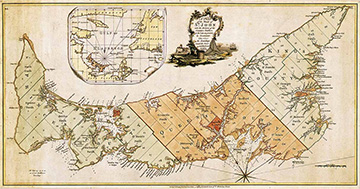
In 1871, the colony began construction of a railway and, frustrated by Great Britain's Colonial Office, began negotiations with the United States. In 1873, Canadian Prime Minister Sir John A. Macdonald, anxious to thwart American expansionism and facing the distraction of the Pacific Scandal, negotiated for Prince Edward Island to join Canada. The Dominion Government of Canada assumed the colony's extensive railway debts and agreed to finance a buy-out of the last of the colony's absentee landlords to free the island of leasehold tenure and from any new immigrants entering the island (accomplished through the passage of the Land Purchase Act, 1875). Prince Edward Island entered Confederation on July 1, 1873.
As a result of having hosted the inaugural meeting of Confederation, the Charlottetown Conference, Prince Edward Island presents itself as the "Birthplace of Confederation" and this is commemorated through several buildings, a ferry vessel, and the Confederation Bridge (constructed 1993 to 1997). The most prominent building in the province honouring this event is the Confederation Centre of the Arts, presented as a gift to Prince Edward Islanders by the 10 provincial governments and the Federal Government upon the centenary of the Charlottetown Conference, where it stands in Charlottetown as a national monument to the "Fathers of Confederation". The Centre is one of the 22 National Historic Sites of Canada located in Prince Edward Island.
Source : Wikipedia